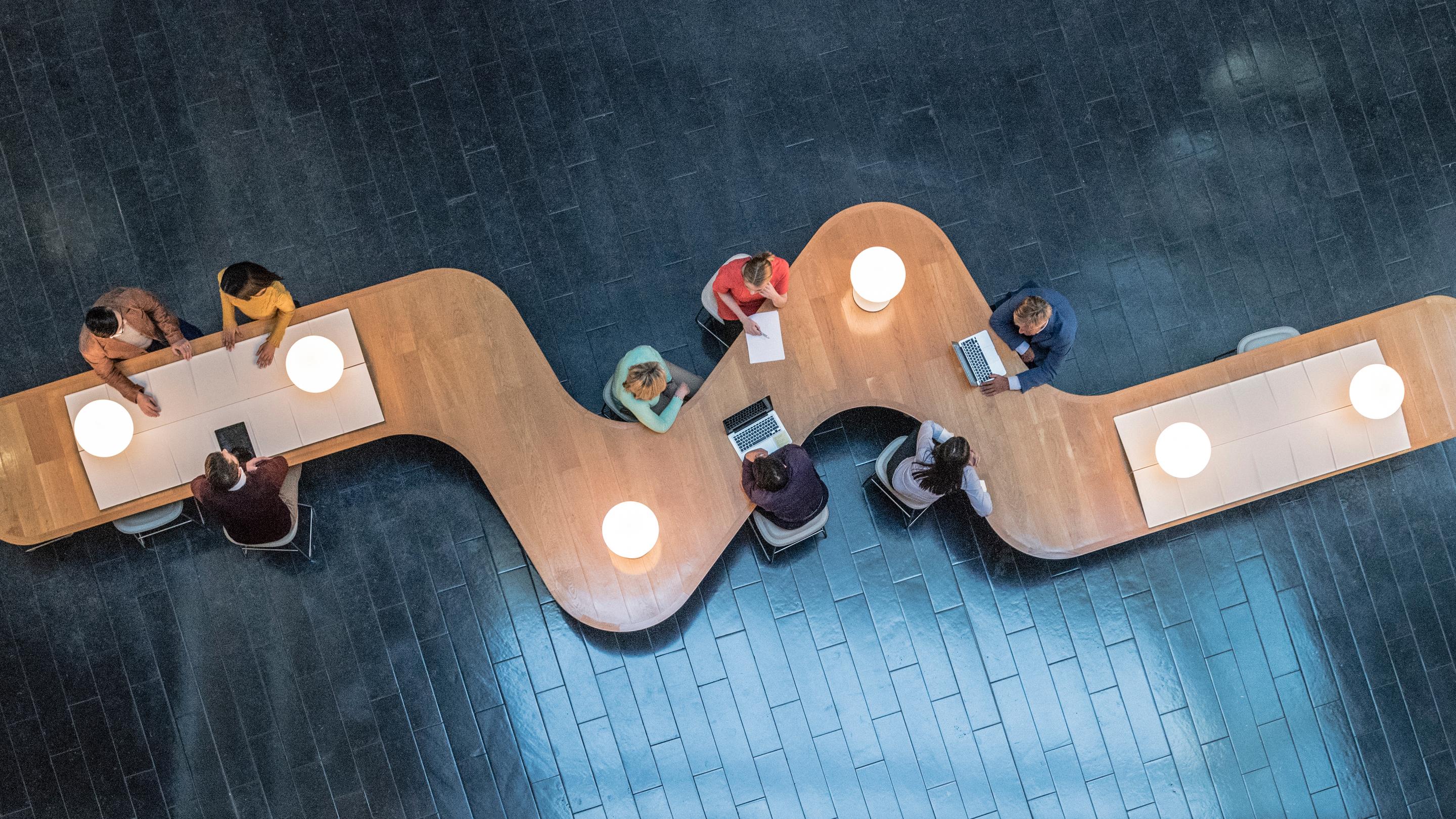Radically rethink and reinvent work design

Recent events have taught us that work can transition at light speed — and that agile organisations are better equipped than others to thrive and weather rough storms. Although leaders continue to prepare for the future of work by tracking predictable trends, establishing the agility to take on unforeseeable events has become a priority. Such agility calls for thinking about what work is, how tasks get done and who (or what) is best suited to perform those tasks. This means creating a new operating model that reflects the fluidity of modern work and working arrangements instead of relying on antiquated jobs created for a vastly different world.
In other words, sometimes you have to break down a structure to rebuild it sustainably. That’s the newest, cutting-edge idea in work design. Agile organisations realise that fixed, inflexible job architectures fail to capture the realities of today’s work, account for socioeconomic developments or meet the needs of the people who perform the work — many of whom no longer desire a nine-to-five career.
The status quo is no longer working — and it no longer has to, if leaders are ready to radically rethink the way work is performed.
The evolution of work
Work has changed dramatically over the decades, starting simply as jobs in the late 19th and early 20th centuries and developing into more complex careers in the 1960s and 1990s.
The early 2000s added gig work to jobs and careers. More work was delivered through flexible arrangements as full-time work began to give way to myriad new work relationships and rising automation. Then, in the pandemic’s wake, the constructs of traditional employment began to dissolve even more rapidly. Organisations the world over were unexpectedly forced to embrace greater flexibility and accelerated digitalisation.
What’s next? We’re beginning to think of work in unprecedented terms — focusing on the skills, networks, experiences and capabilities that underpin work. These can take on many different forms (jobs, assignments, gigs, etc.) and can be performed by a plurality of work options (employees in full-time roles, employees in agile talent pools, external gig workers, outsourcing, robotic process automation, social robotics, etc.). In other words, sometimes you have to break down a structure to rebuild it sustainably. That’s the newest, cutting-edge idea in work design. Agile organisations realise that fixed, inflexible job architectures fail to capture the realities of today’s work, account for socioeconomic developments or meet the needs of the people who perform the work — many of whom no longer desire a nine-to-five career.
The future of work design
Given this evolution and the demand for greater agility, we need a change in how we think about work design. Designing sustainable and resilient work requires deconstructing jobs and processes into tasks and activities. This allows us to redeploy tasks to optimal work options and reconstruct new, more impactful jobs and processes while clearly understanding the implications for skills and capabilities.
Redesigning work may help resolve common challenges facing organisations around the world and across industries:
-
How can we hire enough people — and the right people — without paying more?
-
How do we make work more attractive to current and future talent?
-
How can we reduce labour costs without undergoing a reduction in force?
-
As we introduce new technology, how do we increase productivity and realise planned savings?
-
How do we effectively introduce gig talent into our business model?
-
How do we create a talent marketplace? How can we help our managers rethink how they get work done? How can work be reconstructed into projects promoted through a talent marketplace?
What’s accelerating the need for a new work model?
-
Employee attrition
Thanks to the “Great Resignation,” talent attraction and retention are top of mind for executives, with 50% anticipating that their organisations will struggle to meet demand for their services and products with their current talent models. Those who say they will struggle to meet demand with current talent models are also:
- Impacted by changing or high staff turnover/resignations (35%)
- Seeing an increase in “quiet quitting” (32%)
- Facing difficulty hiring the right talent, at the right price, quickly enough (29%)
-
Skills gapsDespite 91% of employees saying they learnt a new skill recently, 98% of companies still report significant skills gaps. HR and risk managers alike rank skills obsolescence as a top risk. Moreover, nearly half (47%) of companies still need to develop an approach for classifying skills, a critical step toward a successful skills-based talent strategy.
-
New employee prioritiesMost employees say the pandemic has caused them to rethink what’s important to them, and only two in five say their companies are meeting all their needs. People are asking new questions, such as What do I want to do with my life and career? Are my values aligned with those of the company I work for? Does this work help me fulfil my sense of purpose?
-
The democratisation of work opportunitiesThe growing ability to separate work from the traditional confines of space, time and structure allows employees to access and engage in more meaningful work aligned with their goals and interests. This enhances the employee experience while increasing productivity. In fact, thriving employees are twice as likely to report feeling in control of their careers when working remotely, find pay/promotion decisions fair and equitable, and believe they have a say in the future of work.
Getting on board with modern work design:
of companies are co-creating new employee experiences with their people
of HR professionals say their organisations have technology platforms to ensure transparent opportunities for gig workers
of companies have redesigned roles as fully agile, traditional, or a blend of both or plan to do so this year
of high-growth companies have flow-to-work models on the agenda for the next two years
The new currency of work
Progressive organisations will embrace today’s challenges, seeing them as opportunities to prepare for a better tomorrow. They will change how they design work — bending the demand side of the work equation to match it to available talent rather than the other way around.
To keep the workers they need, leaders tend to fall back on conventional solutions — for example, paying more. Although pay remains a key factor in why employees stay, a newer approach is to ride the momentum of post-pandemic flexibility, offering more options around where and when work is done.
Some leading organisations are going further — deconstructing jobs into tasks and skills, pulling untenable roles apart, and delivering work in an increasingly agile way. By focusing on the skills and work that are needed instead of on fixed, legacy job descriptions, these organisations will tear down the rigidity of the traditional structure. In its place, they’ll build new, malleable organisations that can deploy the right talent working in the right ways in the right places at the right time and cost. These agile organisations will be able to adapt swiftly to whatever the future brings.
Leading organisations will also be more human centric. This means focusing on attracting and retaining the right people by offering flexibility that aligns with workers’ personal and professional goals and providing plenty of options around where and when work is done.
Work design creates efficiency, agility and resilience. It helps the organisation and culture evolve to embrace the new work arrangements that will productively retain and engage talent.
Case study: Oil and gas company fuels agile, profitable work design
A major oil and gas company redesigned the work on its oil rigs to significantly improve performance and the work experience. Activities were centralised (through the use of sensors embedded in equipment so they could be monitored remotely), shifted (from permanent onsite workers to shared services teams for maintenance), augmented (through the use of AI) and eliminated (through the introduction of robotics). Automation also created new activities, such as electrical/mechanical engineering and data analytics. There was no reduction in headcount as talent was upskilled and reskilled from legacy to new activities.
By deconstructing jobs, redeploying tasks and reconstructing new jobs, the company realised a 45% improvement in profitability — just one example of the benefits of work design.
Rethinking work design: Four new principles
Work design: Three phases of action
-
Deconstruct jobsIn today’s typical organisation, work is “constructed” into job descriptions. By breaking down jobs into component tasks or projects, organisations can gain a better understanding of the work itself — what it is, why it’s needed, how it’s delivered, and who does the work and why. This process provides a clearer picture of the capabilities and skills needed to perform work and allows companies to explore how work and its underlying tasks and skills will change in the future.
-
Redeploy tasksOnce jobs and processes are broken down into their basic building blocks, organisations can think through how they can best be completed. By starting with the work, it’s easier to analyse and identify which tasks can be substituted or enhanced by automation and which can be performed by alternative work arrangements. Such arrangements can include gig work, internal talent marketplaces, outsourcing and shared services. This approach also provides a better understanding of the implications for cost, capability and productivity.
-
Reconstruct workThis requires exploring how to reorganise the work strategically, creating new and fundamentally different jobs and workflows that optimise the work options and talent available now. This rethinking enables continual reinvention of how work is done as automation options and people’s preferences change well into the future. It also enables you to understand the skills you need for a more efficient and sustainable operation.
Act now to become skills focused and future ready
1 All statistics from Mercer’s Global Talent Trends 2022–23 Study unless otherwise noted.
Senior Partner, Global Transformation Services Leader
Principal and Global Solution Leader for Work Design, Mercer
Related solutions
-
Attract & retain talentMercer’s strategic workforce planning solutions provide a rational business basis to prioritise, develop and fund the people practices needed to support business…
-
Talent & transformation
Organisation design
Mercer’s organisation design consulting can help you transition from a traditional multilayered organisation to a simple, agile and distributed structure. -
AI Pathmaker: Charting a path to thrive with AI
At Mercer, we partner with you to seize this moment to transform work and HR for good.
Related insights
-
Skills-powered organisations
Interview: Leading the skills-powered enterprise
Ravin Jesuthasan discussed enhancing agility and AI readiness at MIT’s Work/25 summit, focusing on remote work, diversity, and supportive employee conditions. -
Future of work
The age of opportunity: How to lead in the longevity economy
Discover how employers can support financial wellbeing, healthy living and career development across the lifespan. -
Skills-powered organisations
Survey report insights: Global Skills Technology and Adoption
Organizations are increasingly recognizing the importance of skills management as a critical component of their talent strategies.








